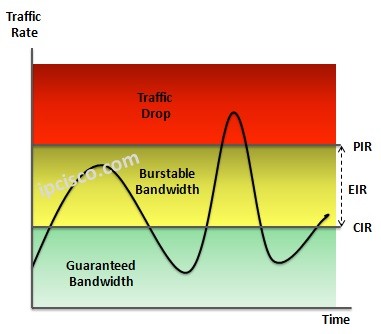- COURSES
- SPECIALS
- BLOG
- MEMBERS
- SHOP
- ABOUT
- ENROLL HERE

In Metro Ethernet links, the traffic rates are not stable always. Sometimes the traffic rates increase, sometimes they decrease. To overcome and manage this issue, some key parameters are used. This parameters provide to determine guaranteed (without loss) traffic rates, burst traffic rates and drop limits.
What are these key terms? These key terms are :
• CIR (Committed Information Rate)
• CBS (Committed Burst Size)
• EIR (Excess Information Rate)
• PIR (Peak Information Rate)
• MBS (Maximum Burst Size)
CIR (Committed Information Rate) is the minimum guaranteed traffic delivered in the network.
CBS (Committed Burst Size) is the flexibility of your provider, the maximum bytes allowed to exceed your CIR to be still CIR confirmed.
Think about this. If you need avarage 10 Mb bandwidth.This can be written on your SLA as CIR (Committed Information Rate). Beside this, there is also a case that your provider can be flexible. For example, your provider is flexible for 1Mb of your bandwidth and if you do not exceed 11Mb value, then your traffic will not be discarded or shaped. This is your CBS (Committed Burst Size). CBS is the customer traffic size that is allowed to burst.
EIR (Excess Information Rate) is the maximum allowed traffic amouth during a non busy times without any guarantee.
PIR (Peak Information Rate) is the top bandwith point of allowed traffic in a non busy times without any guarante.
MBS (Maximum Burst Size) or EBS is the flexibility of your provider for PIR like CBS for CIR.
The traffic situation at CIR and PIR values is showed with colors also. Here, three colors are used. Green, Yellow and Red.

Leave a Reply